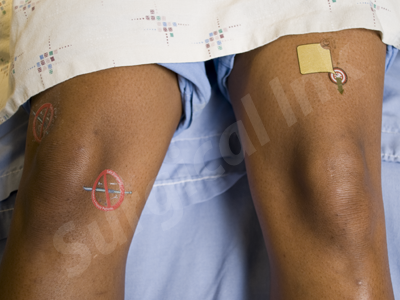Don't Cut Tattoo Designs
The decision whether to utilize Don’t Cut tattoos is individual to each hospital, free-standing surgical center and surgeon. Some authorities suggest that marking only the surgical site may be the most effective means of reducing “wrong-site, wrong-procedure, wrong-patient” surgery. However, there are still too many errors…particularly where bi-lateral body symmetry is involved.
The incidence of wrong- site, wrong-procedure surgical error, when laterality is part of the equation, is statistically greater than when laterality is not a factor. If this were not the case, the premise of marking only the surgical site may have some basis in fact. In that this conclusion is not supported by the facts, it is logical to deduce that unambiguous marking of the non-surgical part of the body, in conjunction with correct site marking, may be effective in helping to eliminate this problematic circumstance.
Surgical Ink® Don’t Cut designs utilize the International No Symbol overlying surgical instruments and select commercially available power tools. The International No Symbol is a universally recognized image not subject to misinterpretation. This global symbol immediately and unambiguously conveys the intended message to all who encounter it.
These designs make it possible for the hospital, free-standing surgical center and surgical team to further protect the patient while maintaining a professional demeanor, thereby strengthening the solemn nature of any surgical procedure, irrespective how common or simple that procedure may be.
Surgical Ink® guidelines recommend the use of multiple Don’t Cut tattoos for each surgical procedure. The application of multiple Don’t Cut tattoos, on the non-surgical portion of the body, helps establish effective communication and agreement between all members of the surgical team and the patient. The patient and surgical team identify and agree upon the non-surgical portion of the body multiple times during the application of the Don’t Cut tattoos. Through multiple applications, the patient and the surgical team will affirm and reaffirm proper marking of the patient’s body. In reality, redundancy becomes a broad safety net for patients, hospitals, free-standing surgical centers, surgical teams and regulatory authorities alike.
